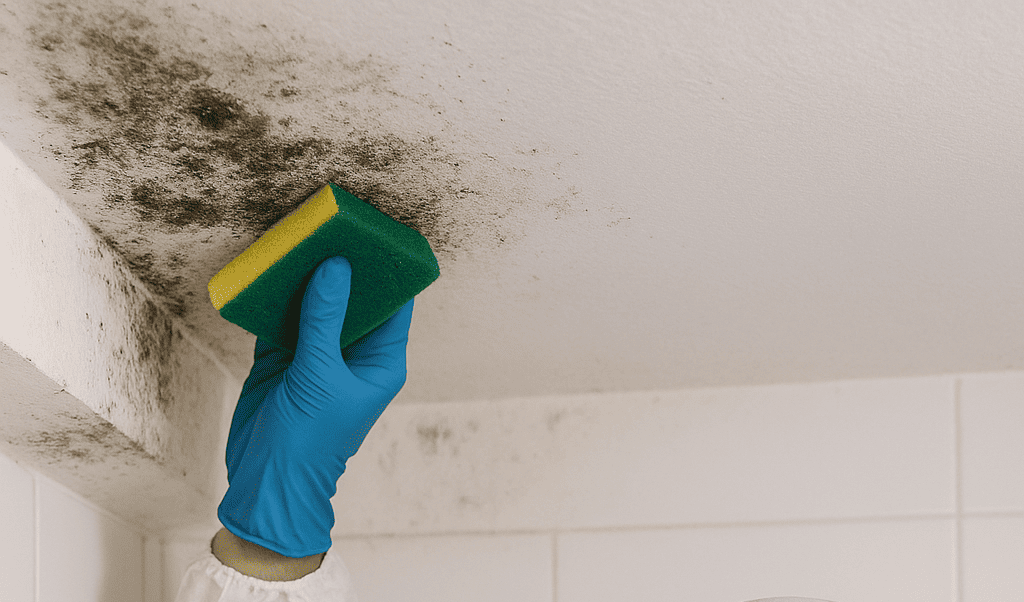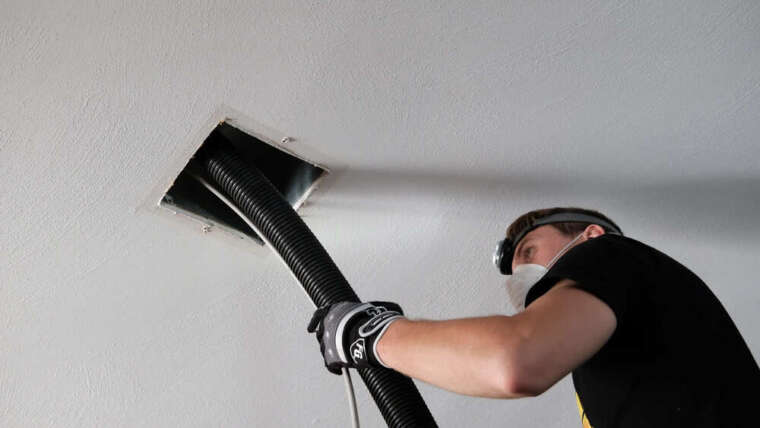
Mold on a bathroom ceiling isn’t just an unsightly problem—it can also pose serious health risks if left untreated. Many homeowners are shocked to find those dark, patchy bathroom ceiling mold spots slowly spreading over time. The ceiling mold in bathroom areas often stems from a combination of poor ventilation and constant humidity, making bathrooms one of the most common locations for mold growth. Understanding what causes mold on bathroom ceiling surfaces is the first step toward tackling it effectively. In this guide, we’ll cover how to remove mold from bathroom ceiling surfaces, explore the best mold remover for bathroom ceiling, and help you take preventive measures.
Why Is There Mold on My Bathroom Ceiling?
The appearance of mold on a bathroom ceiling is often the result of repeated condensation, poor air circulation, or a lack of insulation. When warm, moist air rises after a shower and has nowhere to escape, it clings to cold ceiling surfaces, creating the perfect breeding ground for mold. Mold spots on bathroom ceiling tiles or paint may start as faint discoloration and quickly become dense patches of black or greenish growth. If you’ve ever asked yourself how to stop mold on bathroom ceiling, it starts with understanding the environment mold thrives in.
Bathroom mold ceiling issues are common in homes with underperforming exhaust fans or no ventilation system at all. Investing in proper ventilation, such as air duct cleaning services from professionals, can help maintain air quality and reduce the risk of mold growth in the future.
How to Remove Mold from Bathroom Ceiling

If you’ve been wondering, how do you remove mold from bathroom ceiling spaces safely and effectively, there are a few crucial steps to follow. First, ensure the room is well-ventilated by opening windows or turning on an exhaust fan. Always wear protective gear—gloves, goggles, and a mask—to avoid inhaling spores or exposing your skin.
There are various cleaning solutions available, including natural and chemical options. Before you start removing bathroom mold, test a small section to ensure your chosen product won’t damage the surface. If you’re dealing with a severe infestation, consider hiring a mold removal service to ensure complete remediation. Best Way to Remove Mold from Bathroom Ceiling. When it comes to removing mold from ceiling in bathroom spaces, there’s no one-size-fits-all solution—but several proven methods can help eliminate mold and stop it from returning.
Each technique varies in strength, safety, and suitability depending on the severity of the mold and your preferences. Below is a detailed look at the best way to remove mold from bathroom ceiling, including both DIY and long-term prevention strategies.
1. Bleach and Water Solution
A traditional and highly effective method for killing mold on bathroom ceiling areas involves a mixture of one part bleach to three parts water. Apply the solution generously to the affected area using a spray bottle or sponge. Allow it to sit for 15–20 minutes to penetrate and disinfect the mold before scrubbing thoroughly with a stiff brush. While effective, this method should be used with caution in well-ventilated spaces due to the strong fumes.
2. White Vinegar Spray
For a gentler, non-toxic approach, undiluted white vinegar can be sprayed directly onto the mold. Let it sit for at least an hour to break down the mold spores, then wipe it away with a damp cloth. Vinegar not only removes surface mold but also has mild antifungal properties, making it a safe option for households with pets or children and ideal for routine bathroom mold ceiling maintenance.
3. Hydrogen Peroxide Application
Using 3% hydrogen peroxide is another effective method for mold on bathroom ceiling removal. Spray it directly onto the affected surface and wait 10 to 15 minutes as it bubbles and lifts the mold from the ceiling. Scrub the area with a brush and wipe clean. This method is especially good for mold removal in bathroom settings where strong chemical odours are undesirable.
4. Baking Soda Paste
Baking soda is a gentle yet powerful option for removing mold bathroom ceiling spots. Create a paste with baking soda and water, apply it to the mold, and scrub with a sponge or brush. It’s ideal for small patches and regular maintenance since baking soda also deodorizes and absorbs moisture, helping prevent future mold growth.
5. Professional HVAC Upgrades
Mold thrives in warm, humid environments, which is why upgrading your HVAC system can be a long-term solution. Installing a pro hvac uv light installation system can help disinfect air circulating through the bathroom, killing airborne mold spores before they settle. This proactive approach is excellent for ongoing air quality control and preventing recurring ceiling mold in bathroom areas.
6. Dehumidifier Installation
Keeping humidity levels low is one of the most effective ways to prevent mold bathroom ceiling problems. A small bathroom dehumidifier removes excess moisture from the air, creating an inhospitable environment for mold growth. Set it to maintain relative humidity below 60%, especially after showers.
7. Ceiling Paint with Mold Resistance
Once you remove mold from bathroom ceiling, finishing the job with anti-mold ceiling paint adds a protective barrier. These paints are specially formulated with antimicrobial properties to resist moisture and fungal growth, making them an essential final step in bathroom mold removal ceiling treatment.
Together, these methods offer both immediate relief and long-term prevention for homeowners dealing with mold spots on bathroom ceiling surfaces. Choose the right combination of strategies to ensure your bathroom stays mold-free and healthy.
Symptoms of Mold Exposure from Bathroom Ceilings
 Recognizing the signs of mold exposure can help you act before it becomes a health issue. The symptoms often mimic allergic reactions and respiratory problems. Below are common indicators:
Recognizing the signs of mold exposure can help you act before it becomes a health issue. The symptoms often mimic allergic reactions and respiratory problems. Below are common indicators:
- Persistent coughing and sneezing – Mold spores irritate the respiratory system and may lead to chronic symptoms.
- Eye irritation – Redness, itchiness, or watery eyes may result from direct exposure.
- Skin rashes – Mold can trigger dermatitis in sensitive individuals.
- Headaches or fatigue – Ongoing mold exposure may cause neurological effects like headaches or general tiredness.
- Worsening asthma symptoms – For those with asthma, exposure to mold can lead to more frequent and severe attacks.
- Musty odours – An earthy, stale smell is a telltale sign of hidden mold behind ceilings or walls.
How to Prevent Bathroom Ceiling Mold
Prevention is key. If you’ve already dealt with mold on a bathroom ceiling, it’s time to make sure it doesn’t come back. Regularly run your exhaust fan during and after showers, keep surfaces dry, and clean your ceiling monthly with a vinegar-based solution. Sealing grout and repainting with mold-resistant products also strengthens your bathroom’s defence.
Partnering with indoor air experts like Promaster can further support your mold prevention goals through inspections, upgrades, and regular maintenance.
Conclusion
Dealing with mold on a bathroom ceiling is more than just a cosmetic concern—it’s a matter of health, safety, and home maintenance. From understanding what causes mold on bathroom ceiling surfaces to learning how to remove mold from a bathroom ceiling using effective DIY methods or professional help, this guide has outlined the most reliable solutions. Whether you’re scrubbing away small bathroom ceiling mold spots or tackling a severe infestation, proper ventilation, regular cleaning, and moisture control are essential.
For long-term protection, investing in air quality improvements like air duct cleaning services and pro HVAC UV light installation can make a substantial difference. And if the problem becomes overwhelming, contacting a certified mold removal service is the safest course of action. By staying informed and proactive, you can maintain a cleaner, healthier bathroom environment and effectively prevent mold bathroom ceiling issues in the future.


